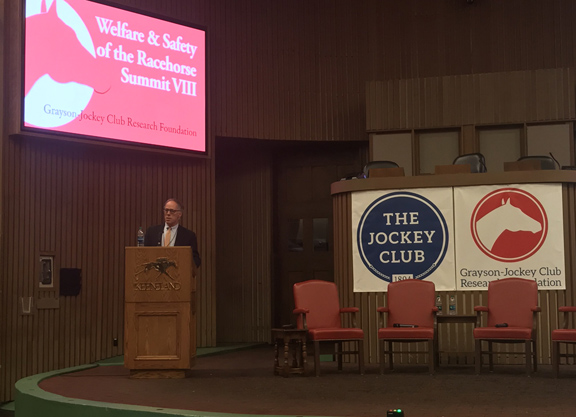Last week, it was announced that National Thoroughbred Racing Association Charities was gifting $100,000 to enable the University of Kentucky to further support equine surfaces and safety research under the direction of Mick Peterson, director of UK Ag Equine Programs. Peterson, a nationally known expert in surface safety and faculty member in the UK Department of Biosystems and Agricultural Engineering, recently sat down with the NTRA to provide greater insight on the new laboratory and what initiatives he hopes to see enacted as a result. Below is an edited transcript of that conversation.
Q: How is this new lab different than the Racing Surfaces Testing Laboratory? What are some of the testing that will be able to take place now that hasn't previously?
MP: We really have three steps to this. One is, we need to make sure that the material is appropriate to be able to race on. That is what the Racing Surfaces Testing Laboratory does. There is a second entity that is an LLC that goes and certifies the racetrack before every race meet and so they're basically going and the engineer works for me and we basically work on making sure that if the track is perfectly maintained that we will be able to have a consistent racing surface. But the third piece of this– which is the most difficult and where we have the biggest challenges–is making sure that the maintenance is appropriate to the weather and that the response every day is optimal for the safety of the surface. Right now, we are way behind on that third piece and that third piece is interesting because it includes both technology and people.
Right now we're completely dependent on someone at the track doing that hard work and paying attention. The goal with this lab is not only to train more of those people who can do a good job of tracking the day to day maintenance but also to automate more of it.
Q: How key has the NTRA Safety and Integrity Alliance been– in particular with its in-field experiences across the country–in identifying a need for this space and moving this needle forward?
MP: There is almost a 100% overlap between the people who have a commitment to the Safety and Integrity Alliance and the accreditation and the people who I'm working with. It's the accredited tracks that really get it. And the accreditation process is a dynamic discussion that actually pushes the tracks to think about the technologies that they need and the human resources they need in order to produce the optimal racing surface and the optimal overall racing environment. So this goes back to the very beginning of the founding of the Safety and Integrity Alliance–this was an original partnership.
Q: Some existing funded projects will move into the lab on day one. Is it safe to say this is just the beginning and there are numerous future projects that will need funding?
MP: There are so many things we can be doing to support the industry and it starts out with how we tend to talk a lot about main tracks and dirt track surfaces in general. There is a huge need right now to look at turf racing. There is so much pressure on the turf courses. The turf courses are small traditionally in the United States, they're ovals on the inside and there just isn't that much area. And if you talk to racing secretaries, they say 'I do six turf races a day'. We do not have the infrastructure for that. So, some of the projects we are looking at are things like how we repair divots, how we look at watering on the turf track. Everything needs to be on the table in order to protect the integrity of the surfaces to protect the horses.
Q: To put it mildly, funding the science seems like such a key intangible toward meaningful change.
MP: I had a professor when I was in graduate school say that you are looking for solvable, unsolved problems. And I look at surfaces and there are a lot of solvable unsolved problems. We've got some challenges–the risk to a rider when a horse clips heels. You can train stewards, you can train jockeys, you can look at shoe design but some of that risk is inherent to racing. When we talk about an uneven turf surface or inconsistent moisture on the main track, we can fix that. And so, I think that's one of the key takeaways on this.
Not a subscriber? Click here to sign up for the daily PDF or alerts.






